Rakvere
Rakvere | |
|---|---|
View over Rakvere | |
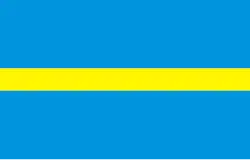 Flag 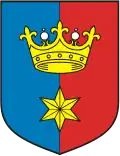 Coat of arms | |
| Motto: Väge täis (Full of might) | |
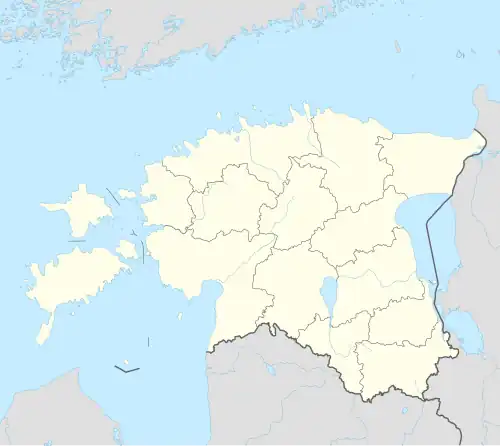 Rakvere Location in Estonia 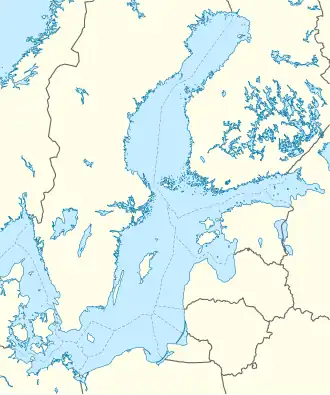 Rakvere Rakvere (Baltic Sea) | |
| Coordinates: 59°21′N 26°21′E / 59.350°N 26.350°E | |
| Country | Estonia |
| County | Lääne-Viru County |
| Government | |
| • Mayor | Triin Varek (Isamaa) |
| Area | |
• Total | 10.75 km2 (4.15 sq mi) |
| Elevation | 82 m (269 ft) |
| Population (2024) | |
• Total | 15,516 |
| • Rank | 8th |
| • Density | 1,400/km2 (3,700/sq mi) |
| Ethnicity | |
| • Estonians | 88% |
| • Russians | 9% |
| • other | 3% |
| Time zone | UTC+2 (EET) |
| • Summer (DST) | UTC+3 (EEST) |
| Postal code | 44306 |
| Area code | (+372) 032 |
| ISO 3166 code | EE-663 |
| Vehicle registration | R |
| Website | www |
Rakvere is the administrative center, or county seat, of Lääne-Viru County in northern Estonia, about 100 km southeast of Tallinn and 20 km south of the Gulf of Finland and the Baltic Sea. In 2022, Rakvere was one of 10 ACES European Towns of Sport.[1] In 2023, Rakvere achieved Green Destinations' Silver Award[2] after having been selected in 2021 as part of the Top 100 Destination Sustainability Stories.[3]
Rakvere boasts a distinctive architectural feature: the Rakvere door. Reflecting German baroque cabinets of the 17th and 18th centuries and the expressionist style of the 1920s, the wooden Rakvere door has a pointed, raised rectangle in the center. In 2023, there were 15 Rakvere doors on 13 houses.[4]
Name
A settlement called Tarvanpea, which means the 'head of an aurochs', was first mentioned in 1226 in the Livonian Chronicle of Henry. This Danish stronghold was first recorded as Wesenbergh, the Middle Low German adaptation of Tarvanpea, in 1252, and, up until the early 20th century, the town was widely known as Wesenberg. The name Rakovor appears in 1268 in the Russian Novgorod First Chronicle, and present-day Rakvere is associated with Rägavere, in which vere in Estonian refers to a topographical feature. Rakvere has also been referred to as Tarvanpää.
History
The earliest signs of a human settlement, dating back to the 3rd, 4th, and 5th centuries AD, have been found on Rakvere's Theatre Hill (Teatrimägi). Probably to protect this settlement, a wooden stronghold was built on another hill, or mound, (Vallimägi) nearby, Rakvere's highest point.
After the Kingdom of Denmark conquered northern Estonia, it started to erect stone buildings in 1220. The Battle of Wesenberg, with the Danish and Teutonic knights and local militia on one side and the forces of Novgorod and Pskov on the other, occurred near Rakvere on 18 February 1268. The Danish King Erik VI Menved granted Rakvere Lübeck rights on 12 June 1302.[4] After the king sold Danish Estonia to the Livonian Order in 1346, a large stone castle was built on top of the stronghold on Vallimägi. The Ordensburg was protected by towers and courtyards.
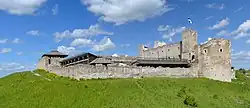
The building of a Franciscan monastery started on Theatre Hill in 1508. Yet, in 1558, during the first year of the Livonian War, Muscovite troops captured Rakvere, and, in 1574, Sweden heavily damaged the town after the disastrous Siege of Wesenberg.[5] In 1581, Sweden captured Rakvere[6] and passed it to the Polish–Lithuanian Commonwealth in 1602; Polish troops destroyed the castle in 1605. After Rakvere returned to Swedish control that same year, a mansion was built on the ruins of the monastery. In 1703, during the Great Northern War, Rakvere was burned down. With the capitulation of Estonia and Livonia in 1710 and the subsequent Treaty of Nystad in 1721, the town became part of the Russian Empire. It was a part of Russia until 1918 when, following World War I, Estonia became an independent nation.
During the period of independence from 1918 to 1940, Estonia completed its first railway, and Rakvere was at the heart of the crucial Tallinn-Rakvere-Narva-St. Petersburg trade route. Telephone lines had been installed in 1898, and nearly the entire city had electric lights in 1918.[4] Many prominent buildings were built, too, in Rakvere, during this period, including the market building, the old bank building (today, SEB Pank), and Rakvere Secondary School (since 2022, Rakvere Freedom School). Local newspapers emerged, including the county paper Virumaa Teataja in 1925. The idea of a professional theatre in Rakvere started to take shape as well. In 1930, during the administration of Mayor Heinrich Aviksoo, the town stadium opened. Later, Anton Soans developed a new master plan from which emerged a private German-language school and a public Estonian-language high school.
With Estonia in World War II, the Soviet Red Army invaded and occupied the country in June 1940.[4] On 14 June 1941, hundreds of Rakvere's residents were deported to Russia.[4] From 7 August 1941 to 19 September 1944, the town was occupied by Germany.[4] In the autumn of 1941, the Dulag 102 prisoner-of-war camp was relocated from Šiauliai to Rakvere, and was later moved to Volosovo.[7] On 19 September 1944, the Soviets bombed the town, killing at least 20 civilians, including two children.[4] The next day the town was re-occupied by the Soviets.[4]
On 20 August 1991, Estonia again declared its independence.[4]
On 15 July 2000, a high-end F2/T5 tornado hit Rakvere, killing one person and injuring one other. The tornado damaged 110 homes and destroyed 120 garage buildings. One car was seen airborne.[8][9]
Transport
The T5 highway to Pärnu starts near Rakvere, and the T1 Tallinn-Narva highway, part of European route E20, is just to the north of the town. Narva is 114 km to the east of Rakvere. The Tallinn-Narva railway passes through the city, and passenger trains between Tallinn and Narva, operated by Elron (rail transit), stop at Rakvere several times a day. Daily busses connect Rakvere to Tallinn and Narva, too, as well as to many small towns throughout Lääne-Viru County, including Tapa and Kunda.
Geography
Rakvere has a total area of 10.75 square kilometres. There are 19 districts, or neighborhoods, in Rakvere: Kondivalu, Kukeküla, Kurikaküla, Lennuvälja, Lepiku, Lilleküla, Linnuriik, Moonaküla, Mõisavälja, Paemurru, Palermo, Roodevälja, Seminari, Südalinn, Taaravainu, Tammiku, Vallimäe, Vanalinn, and Õpetaja Heinamaa. Although about 15% of Rakvere is covered by forests and parks, it is Estonia's third most densely populated urban area.
Demographics
| Ethnicity | 1922[10] | 1934[11] | 1941[12] | 1959[13] | 1970[14] | 1979[15] | 1989[15] | 2000[16] | 2011[17] | 2021[18] | ||||||||||
|---|---|---|---|---|---|---|---|---|---|---|---|---|---|---|---|---|---|---|---|---|
| amount | % | amount | % | amount | % | amount | % | amount | % | amount | % | amount | % | amount | % | amount | % | amount | % | |
| Estonians | 6885 | 89.9 | 9108 | 90.8 | 8099 | 95.7 | 11168 | 78.1 | 13292 | 74.3 | 14550 | 76.5 | 14902 | 75.2 | 14496 | 84.8 | 13445 | 88.1 | 13386 | 88.4 |
| Russians | 304 | 3.97 | 355 | 3.54 | 163 | 1.93 | - | - | 3441 | 19.2 | 3326 | 17.5 | 3545 | 17.9 | 1845 | 10.8 | 1371 | 8.98 | 1155 | 7.63 |
| Ukrainians | - | - | 0 | 0.00 | - | - | - | - | 410 | 2.29 | 355 | 1.87 | 507 | 2.56 | 218 | 1.28 | 150 | 0.98 | 193 | 1.27 |
| Belarusians | - | - | - | - | - | - | - | - | 106 | 0.59 | 108 | 0.57 | 171 | 0.86 | 69 | 0.40 | 46 | 0.30 | 36 | 0.24 |
| Finns | - | - | 22 | 0.22 | 5 | 0.06 | - | - | 394 | 2.20 | 406 | 2.14 | 396 | 2.00 | 277 | 1.62 | 137 | 0.90 | 121 | 0.80 |
| Jews | 101 | 1.32 | 100 | 1.00 | 0 | 0.00 | - | - | 44 | 0.25 | 24 | 0.13 | 23 | 0.12 | 11 | 0.06 | 5 | 0.03 | 0 | 0.00 |
| Latvians | - | - | 21 | 0.21 | 8 | 0.09 | - | - | 26 | 0.15 | 26 | 0.14 | 20 | 0.10 | 5 | 0.03 | 6 | 0.04 | 14 | 0.09 |
| Germans | 256 | 3.34 | 281 | 2.80 | - | - | - | - | - | - | 60 | 0.32 | 88 | 0.44 | 9 | 0.05 | 9 | 0.06 | 8 | 0.05 |
| Tatars | - | - | 9 | 0.09 | - | - | - | - | - | - | 50 | 0.26 | 27 | 0.14 | 21 | 0.12 | 15 | 0.10 | 8 | 0.05 |
| Poles | - | - | 13 | 0.13 | 17 | 0.20 | - | - | - | - | 28 | 0.15 | 22 | 0.11 | 15 | 0.09 | 14 | 0.09 | 12 | 0.08 |
| Lithuanians | - | - | 2 | 0.02 | 2 | 0.02 | - | - | 19 | 0.11 | 20 | 0.11 | 24 | 0.12 | 9 | 0.05 | 6 | 0.04 | 7 | 0.05 |
| unknown | 0 | 0.00 | 42 | 0.42 | 5 | 0.06 | 0 | 0.00 | 0 | 0.00 | 0 | 0.00 | 0 | 0.00 | 50 | 0.29 | 5 | 0.03 | 81 | 0.53 |
| other | 113 | 1.48 | 74 | 0.74 | 167 | 1.97 | 3128 | 21.9 | 159 | 0.89 | 58 | 0.31 | 97 | 0.49 | 72 | 0.42 | 55 | 0.36 | 119 | 0.79 |
| Total | 7659 | 100 | 10027 | 100 | 8466 | 100 | 14296 | 100 | 17891 | 100 | 19011 | 100 | 19822 | 100 | 17097 | 100 | 15264 | 100 | 15141 | 99.9 |
- Unaffiliated (83.2%)
- Lutheran (8.50%)
- Orthodox (4.00%)
- Others Christians (1.80%)
- Others Religions or Unknown (2.50%)
- 0.00%
Landmarks
Rakvere Castle (Linnus)
The oldest known archeological traces of the ancient fortress on Rakvere's Vallimägi hill date from the 5th and 6th centuries. Throughout the ages, Rakvere Castle has belonged to Danish kings, knight-monks of the Livonian Order, and the Swedish and Polish states. During the Polish-Swedish War of 1600-1629, the castle was partly blown up by Polish troops in 1605, and, later, by the Swedish army. The castle has lain in ruins ever since.[19]
Today, permanent exhibitions and seasonal programs and activities in the castle explain everyday life in the 16th century. Visitors can dress as medieval knights and walk through the castle's rooms, including a torture chamber, an alchemist's workshop, and a room of historical artifacts. -->[20]
Rakvere Trinity Church (Kolmainu Kirik)
Trinity Church, Rakvere's Lutheran church, originally called St. Michael Church and dedicated to St. Michael the Archangel,[21] dates from the 15th century. It was designed to also be a stronghold in times of trouble. The tower, the masonry stairway, the sharp edges of the windows, and some pillars have been preserved. The church was severely damaged during the Livonian War and during Polish-Swedish conflicts in the 17th century. It was reconstructed from 1684 to 1693, becoming a three-nave chamber from which the name Trinity Church came. In 1703 and 1708, during the Great Northern War, the church was damaged again. It was reconstructed from 1727 to 1730; a Renaissance-style tower was completed in 1752, which was replaced by a neo-Gothic tower in 1852. The church's interior displays fine craftsmanship, including a Baroque pulpit from 1690 made by Christian Ackermann[22] and the altar wall from 1730 by Johann Valentin Rabe.[23] A statute of an egg and a cock that was on the top of the tower is now in the Rakvere Museum [21]
Long Street (Pikk Tänav)
Long, or Pikk, Street is the oldest street in Rakvere. Most Estonian cities have a Pikk Street, which is like a High Street in the United Kingdom or a Main Street in the United States. In the 19th century and first half of the 20th century, Pikk Street was Rakveres's main shopping street with banks, shops, restaurants, and guesthouses as well as the residences of the town's wealthiest businessmen. In 2016, during the celebration of the 100th Anniversary of the Estonian Republic (Estonian: Eesti Vabariik 100), Rakvere was one of 15 municipalities that won the "Good [sometimes translated as Great] Public Space" competition and received financing from the European Union Regional Development Fund and Enterprise Estonia to reconstruct approximately 700 meters of Pikk Street as a pedestrian-friendly, historical thoroughfare reminiscent of the 19th and early 20th centuries. The National Heritage Board of Estonia (Estonian: Muinsuskaitseamet) recognized Rakvere's project with its 2020 New Building in a Historical Environment award, and, in 2021, Estonia showcased it at Venice's 17th Biennale of Architecture. A sculpture of eight-year-old Estonian: Edith Kotka-Nyman (1932-2017) by G.S. Hansen is at 22 Pikk Street, and, behind her, are the so-called Carrot Stairs (Estonian: Porganditrepp) that lead up to Vallimägi and Rakvere Castle with wider steps at the top and narrower ones at the bottom. [24][25]
Rakvere Theatre and Manor House (Teater ja mõis)
Rakvere is reportedly Europe's smallest town with its own professional theatre.[26]
The roots of Rakvere Theatre date back to 1882. Following independence, Estonian Land Reform of 1919 gave Rakvere's originally Swedish manor house (mõis) to the local government. On 4 May 1920, Mayor Jakob Liiv created the Rakvere Community Center Society (Rahvamaja Selts) to manage the formerly private building. Liiv's leadership helped create Rakvere Theatre. Construction of the theatre building - an addition to the manor house turned community center now cultural center (kultuurikeskus) - was completed at the end of the 1930s. Its festive opening was on 24 February 1940. The theatre survived World War II, and it was renovated in 2005. A cinema was built along a wall of the manor's carriage stable in 2016.
Today, Rakvere Theatre presents 10 new productions each season. The theatre has given Estonia many renowned actors, including Volli Käro, Üllar Saaremäe, Indrek Saar, Ülle Lichtfeldt, and Aarne Üksküla. Since 1990, it has organized the biannual event Baltoscandal, which hosts avant-garde plays and groups from all over the world.
Rakvere Central Square (Keskväljak)
In 2004, Rakvere's central, or town, square got a new, modern look with architects' Otto Kadarik, Mihkel Tüür, and Villem Tomiste's five yellow domes (that also look like umbrellas or chanterelle mushrooms or medieval turret tops) hanging from white semi-arches on cobbled hills. In 2010, the sculpture A Young Man on Bicycle Listening to Music was dedicated to Estonian composer Arvo Pärt, a former resident of Rakvere, in honor of his 75th birthday[27] The sculptors are Aivar Simson and Paul Mänd. Surrounding the young man and the square is Rakvere's central business district, including a historical market building and the SEB Pank building, one of the most representative bank buildings in Estonia designed by Ferdinand Gustav Adoff.
St. Paul's Church (Pauluse Kirik) and Ukuaru Concert Hall (Muusikamaja)
Estonian architect and Rakvere native Alar Kotli designed St. Paul's (Freedom) Church in 1935 to celebrate the 20th anniversary of Estonian independence. Construction started in 1937 but stopped in 1940 due to World War II. The church was consecrated on June 16, 1940, as the Soviet Red Army invaded Estonia. Although St. Paul's is one of the few churches in Estonia with two towers, it was never completed, and the towers were never crowned with its spires.
In 2009, however, the Rakvere Municipality launched an international architectural competition for designs that would transform Kotli's church into a multifunctional music center and concert hall in honor of Arvo Pärt, who lived in Rakvere with his mother from 1938 until at least 1965. Rakvere selected Estonian architects Kristiina Aasvee, Kristiina Hussar, and Anne Kose, working together as Stuudio KAH OÜ, and their 20-million-euro design for what became known as the Ukuaru Concert Hall (Ukuaru Muusikamaja). On March 27, 2025, 85 years late, a spire was rested atop the northwest tower of Kotli's church. The spire for the east tower followed on April 29. The brass flag on the tower has the year 2025, and the one on the east tower has 1940.[28]
Notable buildings
Rakvere Freedom School (Vabaduse Kool)
The building of Rakvere Freedom School (Estonian: Rakvere Vabaduse Kool), designed by alumnus Alar Kotli, is a significant example of Functionalism. A key characteristic of Functionalism (architecture) in school architecture is an open building plan that incorporates plain white wall surfaces and round windows. Opened in 1938 or 1939, Freedom School was one of the first schools to have a separate gymnasium and assembly hall.[29] It housed on of the most expensive pianos, purchased from an English company, used in any Estonian school. Today, local singers and musicians contend that Freedom School's assembly hall has the best acoustics of any school in Lääne Viru County.
From 1940 to 1944, the Ministry of Education of the Estonian Soviet Socialist Republic operated Rakvere I and Rakvere II Secondary Schools in two shifts in the Freedom School building. In 1944, the two schools consolidated under the name Rakvere Secondary School; in 1946, it was the Rakvere Estoinan Secondary School, and, in 1950, Rakvere I Secondary School.
From 1994 to 2022, Freedom School was Rakvere Secondary School (gümnaasium). In 2022, the Estonian Ministry of Education and Research opened a state, or national, high school (Estonian: Rakvere Riigigümnaasium) in a new 4,100-square-meter building,[30] and Freedom School became an elementary school.[31]
Harald Estonian: Henno Jänes, an Estonian patriot, was the director of the school during a period of significant growth - from 1936 until he was dismissed and replaced in August 1940. Jänes fled to Sweden to escape persecution by the Soviet Union. Jänes's son established a scholarship fund in 1993 in his father's name. In 1943, Ado Pajo graduated from the school and fought against Soviet forces in Finland as well as Estonia. Pajo returned to the school in 1950 to teach mathematics for more than 30 years. Established in 2006, the Pajo Memorial Medal recognizes the best mathematics student in each year's graduating class. In 1954, composer Arvo Pärt graduated from the school.[29] (Across the street from Freedom School the Municipality of Rakvere is converting St. Paul's Church, also designed by Kotli, into a multipurpose music center in honor of Pärt.)[32] In 1970, entrepreneur Estonian: Oleg Gross graduated from the school. Established in 2004, the Oleg Gross Award recognizes graduates who are active in their communities.
Public Sculptures
Aurochs Sculpture (Skulptuur Tarvas)
.jpg)
Rakvere's Tarvas statue of an aurochs, by Estonian sculptor Tauno Kangro, is considered the largest animal statue in the Baltic region. Along with its granite pedestal, the bronze sculpture is seven meters long and five meters high and weighs about seven tons. According to archeological excavations, animals like the aurochs once lived around Rakvere.
Unveiled on June 15, 2002, on the edge of Vallimägi in celebration of Rakvere's 700th anniversary, Tarvas pays homage to the town's historical name Tarvanpää and symbolizes the town's motto Väge täis (Full of Strength). The individuals and companies who financed the sculpture are engraved into the granite block.[33]
A Young Man on a Bicycle Listening to Music (Noormees jalgrattal muusikat kuulamas)
In 1949, in order to enjoy symphony broadcasts on Estonian radio, played over the loudspeakers in Rakvere's town square, Arvo Pärt rode his bike around the square.[34] On September 11, 2010, the Young Man on a Bicycle sculpture, created by Aivar Simson and Paul Mänd, was unveiled on the square in honor of Pärt's 75th birthday.
Public Parks
Rakvere Oak Grove Preserve (Estonian: Tammiku maastikukaitseala)
The Oak Grove Preserve, created in 1999 but in existence since to 1939, has hiking trails over 24.5 hectares with information boards along the paths that introduce individuals to tress up to 240-years-old as well as a variety of lichens and birds. The park surrounds a World War II German military cemetery.
Rakvere Manor House Park (Mõisapark)
The park behind Rakvere Theatre was originally a garden for the 16th-century monastery and then a park for the 17th-century manor house. The park is also known as the Theatre Park.
Freedom War Memorial Park (Vabadussõja mälestussammas)
Sports
Athletic facilities
- Rakvere Sports Hall (Rakvere Spordikeskus) (opened in 2004)
- Rakvere Municipal Stadium (Rakvere Linnastaadion) (renovated in 2005)
- Artificial turf football field (built in 2007, renovated in 2016) - adjacent ropes course (2024) and basketball courts
- Rahu Hall - an indoor basketball/volleyball court
- Aqua Tennis Center (2016) with outdoor courts (2021) by reservation and Rakvere People's Park Outdoor Tennis Courts
- Palermo Fitness and Adventure Trails - 2 km and 3 km trails with a children's playground
- Rakvere Disc Golf Park (Discgolfi park) (2018) - 18 baskets, par 3 or 4, over 1,770 meters in a forest
- Skateboard Park (2016) - within walking distance of the artificial turf football field[35]
- Rakvere Indoor Football Field - the 80,000 square meter project of the Estonian Football Union is scheduled to open in January 2026.
Sports clubs
- Basketball
- Rakvere Tarvas – a men's basketball team, Estonian second best basketball club in season 2009/2010. In season 2019/2020 they were 4th. The club takes part in Paf Estonian Latvian basketball league. This is the best basketball league in Estonia. The home ground is Kastani Arena.
- Volleyball
- BMF/Rakvere VK (Võrkpalliklub) – a men's volleyball team in the Men's First (Premier) League (Meeste I Liiga) of the Estonian Volleyball Union (Eesti Võrkpalli Liit) (2024-2025). Their home court is the Rakvere Sports Hall (Rakvere Spordihall).
- Rakvere VK – a men's volleyball team that was a multiple Estonian Champion and Cup winner, which took part in Esiliiga, the second best volleyball league in Estonia.
- Football
- Rakvere JK Tarvas – an amateur football club established in 2004. The club plays in Estonian II liiga (fourth tier in Estonian football). In 2016 they played in Estonian premium league. The home ground is Rakvere linnastaadion.
Sporting events
- Night Run Estonia
- Amateur Sumo World Championships 2008
- U19 EURO2012
Twin Towns / Sister Cities
Rakvere is twinned with:[36]
- Cēsis, Latvia
- Lappeenranta, Finland
- Lapua, Finland
- Lütjenburg, Germany
- Sigtuna, Sweden
- Panevėžys, Lithuania
- Senaki, Georgia
- Szolnok, Hungary
- Vyshhorod, Ukraine
Gallery
-
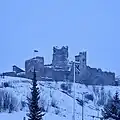 Rakvere Castle Winter 2024
Rakvere Castle Winter 2024 -
 Rakvere central square
Rakvere central square -
Rakvere central square with market building
-
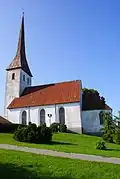 Rakvere Trinity Church
Rakvere Trinity Church -
Pikk Street with Trinity Church
-
.jpg) Buildings on Pikk Street
Buildings on Pikk Street -
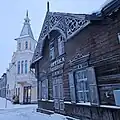 Pikk Street Winter 2024
Pikk Street Winter 2024 -
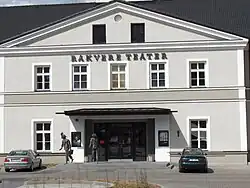 Rakvere Theatre
Rakvere Theatre -
 Rakvere Manorhouse and Theatre
Rakvere Manorhouse and Theatre -
 Rakvere Manorhouse Park
Rakvere Manorhouse Park -
 St. Paul's Church with Two Spires (April 2025)
St. Paul's Church with Two Spires (April 2025) -
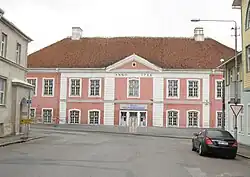 Estonian Police Museum
Estonian Police Museum -
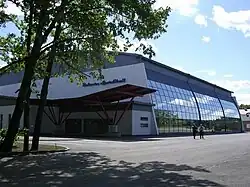 Rakvere Sports Hall
Rakvere Sports Hall -
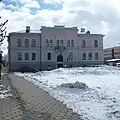 Rakvere County Courthouse
Rakvere County Courthouse
References
- ^ "European Towns of Sport - ACES". aceseurope.eu. Retrieved 24 July 2025.
- ^ "Green Destinations | Our Destination Collection". www.greendestinations.org. Retrieved 24 July 2025.
- ^ "Green holiday in Estonia | Discover the Good Travel Guide". Archived from the original on 12 May 2021. Retrieved 24 July 2025.
- ^ a b c d e f g h i Rakvere Turismiinfokeskus, Rakvere Eng. Retrieved from https://visitrakvere.com/yldinfo/
- ^ Peterson, Gary Dean (2007). Warrior kings of Sweden. The rise of an empire in the sixteenth and seventeenth centuries. McFarland. pp. 91–92. ISBN 978-0-7864-2873-1.
- ^ Black, Jeremy (1996). Warfare. Renaissance to revolution, 1492–1792. Cambridge Illustrated Atlases. Vol. 2. Cambridge University Press. p. 59. ISBN 0-521-47033-1.
- ^ Megargee, Geoffrey P.; Overmans, Rüdiger; Vogt, Wolfgang (2022). The United States Holocaust Memorial Museum Encyclopedia of Camps and Ghettos 1933–1945. Volume IV. Indiana University Press, United States Holocaust Memorial Museum. p. 71. ISBN 978-0-253-06089-1.
- ^ "European Severe Weather Database".
- ^ "Tornaado läks läbi Rakvere".
- ^ 1922 a. üldrahvalugemise andmed. Vihk IV, Viru maakond (tabelid). Eesti riikline statistika (in Estonian and French). Tallinn: Riigi Statistika Keskbüroo. 1924. pp. 12–13. hdl:10062/4451.
- ^ Rahvastiku koostis ja korteriolud. 1.III 1934 rahvaloenduse andmed. Vihk II (in Estonian). Tallinn: Riigi Statistika Keskbüroo. 1935. pp. 47–53.
- ^ Eesti Statistika : kuukiri 1942-03/04 (in German and Estonian). Tallinn: Riigi Statistika Keskbüroo. 1942. pp. 66–67.
- ^ Katus, Kalev; Puur, Allan; Põldma, Asta; Sakkeus, Luule (1996). Rahvastiku ühtlusarvutatud sündmus- ja loendusstatistika: Lääne-Virumaa 1965-1990. Sari C (in Estonian and English). Tallinn: Eesti Kõrgkoolidevaheline Demouuringute Keskus. pp. 31–32. ISBN 9985-820-21-5.
- ^ Население районов, городов и поселков городского типа Эстонской ССР : по данным Всесоюзной переписи населения на 15 января 1970 года (in Russian). Tallinn: Eesti NSV Statistika Keskvalitsus. 1972. p. 78.
- ^ a b Eesti Vabariigi maakondade, linnade ja alevite rahvastik: 1989. a. rahvaloenduse andmed: statistikakogumik. 1. osa: Rahvaarv rahvuse, perekonnaseisu, hariduse ja elatusallikate järgi (in Estonian). Tallinn: Statistikaamet. 1990. pp. 30, 35. ISBN 978-9949-71-932-7.
- ^ "RL222: RAHVASTIK ELUKOHA JA RAHVUSE JÄRGI". Estonian Statistical Database (in Estonian).
- ^ "RL0429: RAHVASTIK RAHVUSE, SOO, VANUSERÜHMA JA ELUKOHA JÄRGI, 31. DETSEMBER 2011". Estonian Statistical Database (in Estonian).
- ^ "RL21429: RAHVASTIK RAHVUSE, SOO, VANUSERÜHMA JA ELUKOHA (HALDUSÜKSUS) JÄRGI, 31. DETSEMBER 2021". Estonian Statistical Database (in Estonian).
- ^ "RAKVERE CASTLE'S HISTORY".
- ^ "Virumaa Museums - Rakvere Castle".
- ^ a b "Rakvere Kolmainu Kirik / Church of the Trinity" monument sign in Trinity Church park, near the bridge, viewed January 11, 2025
- ^ Viirand, Tiiu (2004). Estonia. Cultural Tourism. Kunst Publishers. p. 129. ISBN 9949-407-18-4.
- ^ "Rakvere Kolmainu kirik | Visitrakvere". visitrakvere.com. Retrieved 24 July 2025.
- ^ "Rakvere Stairs". Kavakava. Tallinn: Kavakava Architects. Retrieved 2 October 2024.
- ^ "Historic Pikk street".
- ^ Taul, Gregor. "Turism ja linnamaastikud Pihkvas". Sirp. 22 December 2011. Accessed 4 April 2012. (in Estonian)
- ^ "Market square Rakvere".
- ^ "Ukuaru muusikamaja sai pärast 85 aastast ootust esimese tornikiivri," Rakvere Sõnumid, Rakvere, Eesti, Aprill 2025.
- ^ a b "Rakvere Gümnaasiumi Hoone / Rakvere Secondary School" monument sign at Vabaduse 1 Street, in front of the school, viewed September 15, 2024
- ^ "Tarkuse väega kool – Rakvere Riigigümnaasium". rakvere.edu.ee. Retrieved 24 July 2025.
- ^ "Ajalugu - Rakvere Vabaduse Kool". Archived from the original on 6 February 2023. Retrieved 24 July 2025.
- ^ "Arvo Pärt Music House - Rakvere Linnavalitsus". rakvere.ee. Retrieved 24 July 2025.
- ^ "Tarvas sculpture".
- ^ Joonas Sildre, Between Two Sounds: Arvo Pärt's Journey to His Musical Language, trans. Adam Cullen (Walden, New York: Plough Publishing House, 2024), pp. 29-31
- ^ "Rakvere European Town of Sport 2022 (Rakvere Euroopa Spordilinn)"
- ^ "Sõpruslinnad". rakvere.kovtp.ee (in Estonian). Rakvere linn. Retrieved 7 November 2019.
External links
- Rakvere City Government
- Rakvere Tourist Information
- Estonian Pavilion at the 2021 Biennale of Architecture
- Night photos of Rakvere in winter by Kaiko Lipsmäe Archived 20 July 2011 at the Wayback Machine
- Rakvere Castle Picture gallery at Remains.se
- Population of Rakvere by mother tongue in 1897